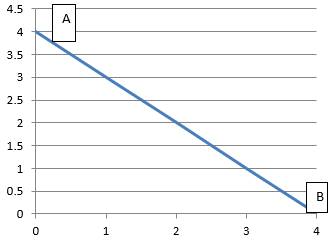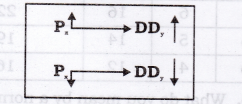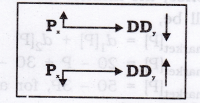NCERT QUESTIONS AND ANSWERS
Q.1 :- What do you mean by budget set of consumer?
Ans. Budget set is a set of all possible combinations of the two goods the consumer can buy from his income at given prices; the cost of these combinations is exactly equal to the income of the consumer or less than it .
Now, let’s say the income of a consumer is Rs 1000 and he has to buy apples and oranges. The price per kg apple is Rs 50 and apple is Rs 20. The possible outcomes could be:

These set of combinations will be called budget set.
Q.2 :- What is budget line?
Ans. Budget line represents the different possible combinations of two goods which can be purchased by consumer with the given income and at prevailing prices and the cost of each of these combinations is equal to the income of consumer.
Q.3:- Explain why budget line is downward sloping?
Ans. The budget line is downward sloping because a consumer can increase the consumption of commodity X only by decreasing the consumption of commodity Y because he has a limited income so he has to make a choice between the quantity of commodity X and commodity Y.
Q. 4:- A consumer wants to consume two goods. The prices of the goods are Rs 4 and Rs 5 respectively. The consumer’s income is Rs 20.
Ans. Let the units purchased two goods be
Goods 1 X and
Goods 2 Y
(i) Equation of the budget line – P1X + P2Y = M
Where
P1 – Price of Good 1 = 4
P2 – Price of Good 2 = 5
M – Income of consumer = 20
X – Units of Good 1
Y – Units of Good 2
Therefore, here the budget line will be expressed as
4X + 5Y = 20
(ii) How much of good 1 can the consumer consume if she spends her entire income on that good
4X + 5(0) = 20
X = 5
(iii) How much of good 2 can she consume if she spends her entire income on that good?
4(0) + 5(Y) = 20
Y = 4
(iv) What is the slope of the budget line?
The slope of budget line is
![]()
– 4/5 = X/Y
X/Y = – 0.8
Q.5 :- How does the budget line change if the consumer’s income increases to Rs. 40 but the price remain same?
Ans. The budget line will be expressed as
4X + 5Y = 40
As income has increased so the consumer can purchase more of both the commodities and the budget line will shift parallelly outwards to A’B’ from AB
The slope of new budget line will be
![]()
– 4/5 = X/Y
X/Y = – 0.8

Q.6:- How does the budget line change if the price of good 2 decreases by a rupee but the price of good 1 and the consumer’s income remain unchanged?
Ans. The budget line will be expressed as
4X + 4Y = 20
The slope of new budget line will be
![]()
– 4/4 = X/Y
X/Y = – 1
The new budget line will also pivot outwards around the same horizontal intercept –

Q.7 :- What happens to the budget set if both the prices as well as the income double?
Ans. The budget line will be expressed as
8X + 10Y = 40
The new budget line will be same as old one with same slope.
Q.8:- Suppose a consumer can afford to buy 6 units of good 1 and 8 units of good 2 if she spends her entire income. The prices of the two goods are Rs 6 and Rs 8 respectively. How much is the consumer’s income?
Ans. Budget line – P1X + P2Y = M
Where,
P1 – Price of Good 1 = 6
P2 – Price of Good 1 = 8
M – Income of consumer = ?
X – Units of Good 1 = 6
Y – Units of Good 2 = 8
M = (6 × 6) + (8 × 8) = 36 + 64 = 100
Therefore, the income of consumer is Rs 100
Q.9:- Suppose a consumer wants to consume two goods which are available only in integer units. The two goods are equally priced at Rs 10 and the consumer’s income is Rs 40.
(i) Write down all the bundles that are available to the consumer.
(i) Here, M = 40
P1 = 10
P2 = 10
The bundles available to the consumer are –
(0,0) (0,1) (0,2) (0,3) (0,4)
(1,0) (1,1) (1,2) (1,3) (2,0)
(2,1) (2,2) (3,0) (3,1) (4,0)
(ii) Among the bundles that are available to the consumer, identify those which
cost her exactly Rs 40
(ii) The bundles available in this case are


Q.10:- What do you mean by ‘monotonic preferences’?
Ans. Monotonic preference means that rational consumer always prefers to have more of a commodity because it will give him a higher level of satisfaction.
More is preferred to less. When preferences are monotone, the consumer prefers more of both the goods. When preferences are strictly monotone the consumer prefers more of one good but not less of the other.
Therefore, a consumer will prefer a particular bundle if it will have at least more of one good but not less of the other good
Q.11:- If a consumer has monotonic preferences, can she be indifferent between the bundles (10, 8) and (8, 6)?
Ans. A consumer having monotonic preference cannot be indifferent between two given bundle because bundle 1 contains more of goods as compared to bundle 2.
So she should prefer bundle 1.
Q.12:- Suppose a consumer’s preferences are monotonic. What can you say about her preference ranking over the bundles (10, 10), (10, 9) and (9, 9)?
Ans. As per monotonic preference, the bundles should be ranked as below –

Q.13:- Suppose your friend is indifferent to the bundles (5, 6) and (6, 6). Are the preferences of your friend monotonic?
Ans. In the given case it shows that the preference of my friend is not monotonic. As he is indifferent towards both the bundles means both the bundles give him same level of satisfaction and so he has assigned them the same rank.
According to the monotonic preference second bundle would have been preferred as it contains more of both the goods
Q.14:- Suppose there are two consumers in the market for a good and their demand functions are as follows:
d1(p) = 20 – p for any price less than or equal to 20, and d1(p) = 0 at any price greater than 20.
d2(p) = 30 – 2p for any price less than or equal to 15 and d1(p) = 0 at any price greater than 15.
Find out the market demand function
Ans. d1(p) = 20 – p for any price less than or equal to 20, and d1(p) = 0 at any price greater than 20.
For Price ≤ 20
Market Demand = 2 (20 – p)
= 40 – 2p
For Price > 20
Market Demand = 2 (0)
= 0
Therefore, market demand function is
40 – 2p if Price ≤ 20
0 if Price > 20
d2(p) = 30 – 2p for any price less than or equal to 15 and d1(p) = 0 at any price greater than 15.
For Price ≤ 15
Market Demand = 2 (30 – 2p)
= 60 – 4p
For Price > 15
Market Demand = 2 (0)
= 0
Therefore, market demand function is
60 – 4p if Price ≤ 15
0 if Price > 15
Q.15:- Suppose there are 20 consumers for a good and they have identical demand functions:
d(p) = 10 – 3p for any price less than or equal to
10/3 and d1(p) = 0 at any price greater than 10/3
What is the market demand function?
Ans. d(p) = 10 – 3p if Price ≤ 10/3
d1(p) = 0 if Price > 10/3
Market Demand is total demand of all consumers
For Price ≤ 10/3
Market Demand = 20 (10 – 3p)
= 200 – 60p
For Price > 10/3
Market Demand = 20 (0)
= 0
Therefore, market demand function is
200 – 60p if Price ≤ 10/3
0 if Price > 10/3
Q.16:- Consider a market where there are just two consumers and suppose their demands for the good are given as follows:
| p | d1 | d2 |
| 1
2 3 4 5 6 |
9
8 7 6 5 4 |
24
20 18 16 14 12 |
Calculate the market demand for the good.
Ans.
| p | d1 | d2 | Market demand = D = d1 + d2 |
| 1
2 3 4 5 6 |
9
8 7 6 5 4 |
24
20 18 16 14 12 |
9 + 24 = 33
8 + 20 = 28 7 + 18 = 25 6 + 16 = 22 5 + 14 = 19 4 + 12 = 16 |
Q.17:- What do you mean by a normal good?
Ans. for normal good, with a raise in income, the demand of the commodity also rises and vice versa. Shortly direct relationship exists the income of a customer and demand of normal good. For example, a new car, new clothings.
Q.18:- What do you mean by an ‘inferior good’? Give some example
Ans. A good is called ‘inferior goods’ when its demand falls with a rise in the income of a consumer and vice- versa.
For example, Jowar or Bajra for a poor person.
A good is inferior in a relative terms. It means, a good is inferior or normal is determined by the income level of a consumer.
When a consumer moves to higher income, he/she may consider some goods below their income status, and treats them as inferior.
Q.19 What do you mean by substitutes? Give examples of two goods which are substitutes of each other
Ans. goods are those goods which can be used in place of another goods and give the same satisfaction to a consumer.

There would always exist a direct relationship between the price of substitute goods and demand for given commodity.
It means with an increase in price of substitute goods, the demand for given commodity also rises and vice-versa.
For example, Pepsi and Coke, tea and coffee are substitute to each other
Q.20:- What do you mean by complements?
Give examples of two goods which are complements of each other.
Ans. Complementary goods are those which are useless in the absence of other goods and which are demanded jointly.

There would always exist an inverse relationship between price of complementary goods and demand for given commodity.
It means, with a rise in price of complementary goods, the demand for given commodity falls and vice-versa.
For example pen and refill, tea and sugar are complements to each other.
Q.21:- Explain price elasticity of demand
Ans. The price elasticity of demand is the percentage change in the quantity demanded of a good or service by the percentage change in the price. In other words, the price elasticity of demand is the rate at which the demand increases or decreases with the corresponding change in price
Q.22:- Consider the demand for a good. At price Rs 4, the demand for the good is 25 units. Suppose price of the good increases to Rs 5, and as a result, the demand for the good falls to 20 units. Calculate the price elasticity .
Ans. P1 = 4, Q1 = 25
P2 = 5, Q2 = 20
ΔP = P2 – P1 = 5 – 4 = 1
ΔQ = Q2 – Q1 = 20 – 25 = -5
ed = ΔQ/ΔP X P/Q
= – 5/1 x 4/25
= – 4/5
ed = – 0.8
Q.23:- Consider the demand curve D (p) = 10 – 3p. What is the elasticity at price 5/3 ?
Ans. 26
D(p) = 10 – 3p
This implies Δq/Δp = -3
At p = 5/3
q will be = 10 – (3×5/3) = 5
Ed = Δq/Δp X p/q
![]()
=-1
- 24 Suppose the price elasticity of demand for a good is – 0.2. If there is a 5 %
increase in the price of the good, by what percentage will the demand for the good go down?
Ans. Price elasticity of demand = -0.2
Increase in price – 5%
![]()
![]()
% Change in Quantity demanded = -0.2 X 5 = -1%
Q.25:- Suppose the price elasticity of demand for a good is – 0.2. How will the expenditure on the good be affected if there is a 10 % increase in the price of the good?
Ans. Price elasticity of demand = -0.2
Increase in price – 10%
The price elasticity is less than 1 so demand is inelastic. In this case the increase in price will result in increase in expenditure. In case on inelastic demand the price and expenditure are positively related.
Q.26:-Suppose there was a 4% decrease in the price of a good, and as a result, the expenditure on the good increased by 2 %. What can you say about the elasticity and demand?
Ans. Decrease in price is 4% whereas increase in expenditure is 2%.The percentage change in price is more than the percentage change in expenditure, which means the percentage change in demand is more than the percentage change in price.
This means the elasticity is more than 1, thus demand is elastic.





